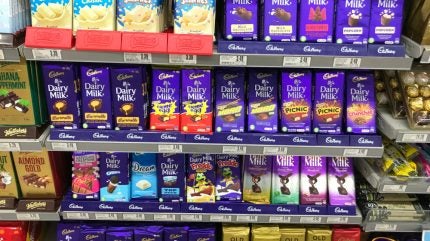
Mondelez International has emphasised how the snacks and chocolate giant’s “geographical diversification” provides an element of protection against tariffs.
However, the Cadbury brand owner has not yet seen the full impact of the latest round of price increases on the consumer, increases that were pretty hefty in Europe in the first quarter at 13.4%.

Discover B2B Marketing That Performs
Combine business intelligence and editorial excellence to reach engaged professionals across 36 leading media platforms.
Volumes did suffer in the three months to 31 March across all of Mondelez’s markets, even though pricing is still being implemented in Europe, Brazil and India in April, May and June. Pricing put in place in the first quarter was 6.6%, with a negative 3.5% impact on volume/mix.
“Pricing execution related to cocoa inflation was strong. We have now implemented planned pricing across many key markets with minimal disruption,” CEO Dirk Van de Put told analysts as he presented the results.
Nevertheless, he added “it’s still to be seen what the reaction is going to be”.
That reaction is obviously dependent on the consumer and variables playing out in individual markets. “Inflation fears” related to tariffs are permeating in the US, while “consumer confidence is soft in Brazil, Mexico and China from economic uncertainty”, Van de Put said.

US Tariffs are shifting - will you react or anticipate?
Don’t let policy changes catch you off guard. Stay proactive with real-time data and expert analysis.
By GlobalDataSentiment in India “remains solid”, he added, despite what he called “inflationary pressures”.
In Europe, however, “consumer confidence and price elasticities remain stable”, the CEO said, even as first-quarter volumes in the region declined 4.5%.
CFO Luca Zaramella emphasised how price negotiations with customers went relatively smoothly as opposed to the “disruption” of last year, providing “pure upside”. Revenue in the quarter climbed 0.2% on a reported basis and was up 3.2% in organic terms to deliver a sales print of $9.3bn.
“Pricing across the board, whether it is chocolate in developed and emerging markets or biscuits in emerging markets specifically, it is absolutely on track,” Zaramella said.
He added that “tariffs [are] causing a small and manageable impact”, particularly as most of Mondelez’s US production is carried out locally.
“Should things worsen in the US, I think we have what it takes to deliver both top and bottom line,” he said, adding: “I can’t rule out the fact that there will be maybe a little bit more pressure going forward from tariffs”.
Cocoa equation
With pricing implemented against cocoa or currently being implemented, Zaramella spelt out the benefits for Mondelez as prices for cocoa butter, which it buys the most of as opposed to cocoa powder, “are already coming down for 2026”.
He explained at length: “Our goal is to exit the year with minimal elasticity or elasticities in line with what we expected. And with the gross profit dollar, that makes sense because we truly believe that even if cocoa comes down, that will allow us to expand gross profit dollar in absolute terms and to reinvest materially back in the category.”
The CFO continued: “If cocoa comes down, I think quite frankly, it is nirvana for us because the level that we will be priced to and the ability that lower cocoa prices will give us to reinvest in the business, considering that our share is up and that we are holding the line in terms of price points, particularly in emerging markets, I think will position us well for the years to come.
“If cocoa stays high, quite frankly, I would say, we don’t expect at this point in time a material headwind into 2026.”
John Baumgartner, managing director at Japanese investment bank Mizuho Securities, gave his thoughts in a follow-up research note.
“It remains early in what’s likely to evolve as a volatile year for macros, but Mondelez continues to excel in controlling the controllables. Cocoa price pass-thru has been largely landed across Europe without notable disruption and multi-layered consumer engagement (price pack, innovation, brand investment) limits elasticity and drives market share gains.
“Coupled with distribution growth, sales across emerging markets should accelerate in H2, while historically high productivity savings provide fuel for reinvestment and cocoa inflation mitigation.”
Despite what Van de Put described as a “challenging macro environment” and “macroeconomic uncertainty” related to the consumer, Mondelez reaffirmed its full-year guidance – organic revenue growth of around 5% and about a 10% decline in adjusted EPS “due to unprecedented cocoa cost inflation”.
“The outlook is provided in the context of greater than usual volatility, including due to geopolitical, trade and regulatory uncertainty and commodity prices,” Mondelez said.
Navigate the shifting tariff landscape with real-time data and market-leading analysis.
Request a free demo for GlobalData’s Strategic Intelligence here.





